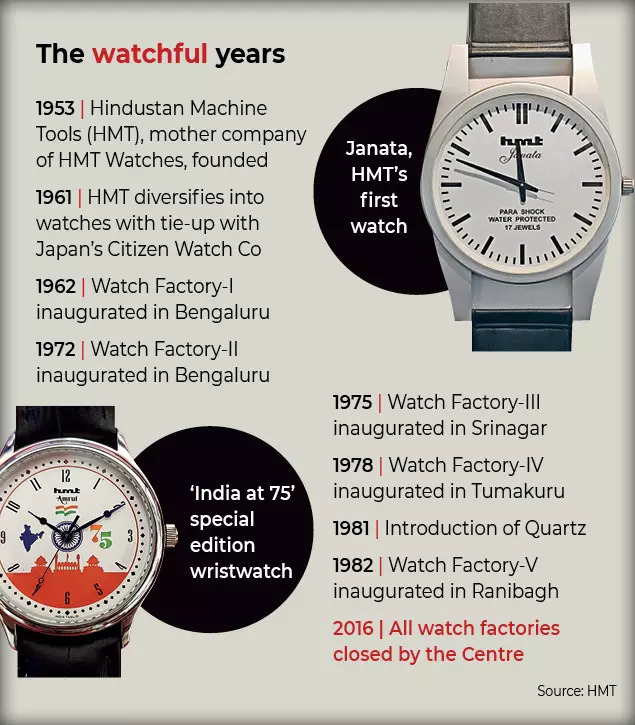Hindustan Machine Tools (HMT)
This is a collection of articles archived for the excellence of their content. Additional information may please be sent as messages to the Facebook community, Indpaedia.com. All information used will be gratefully acknowledged in your name.
This is a collection of articles archived for the excellence of their content. |
History
1953- 2021
Chethan Kumar, Dec 20, 2021: The Times of India

From: Chethan Kumar, Dec 20, 2021: The Times of India
In 1977, more than 15 years after India produced its first wristwatch, an advertisement from the manufacturer read: “We’ve built it so that it will still be around, ticking away faithfully, years and years from now.” That company has sold more than 11 crore pieces so far and most of them are still ticking away faithfully, even as it itself survives on borrowed time.
The story of HMT begins in an age when watches were earned, not bought on a whim. They were prized possessions. Some got theirs for clearing a board exam, others inherited them as family heirlooms. Anecdotally, HMT watches were the sine qua non for grooms at weddings.
As India celebrates 75 years of Independence, the grains of sand in her hourglass tell the story of HMT Watches — once the timekeeper to the nation — ushered in by the first Prime Minister, Jawaharlal Nehru.
“HMT made watches for every occasion, every mood and every generation. From simple hand-wound mechanical watches to elegant, sophisticated quartz watches — analog and digital,” the company proudly proclaims.
HMT’s journey is punctuated with various firsts, including India’s first Braille watch and a watch designed specially for nurses. It was the first public sector undertaking (PSU) to make a product directly for the consumer, and the first to set up a unit in J&K — HMT Chinar Watches was established in 1975. HMT factories also hired women in large numbers in the 1960s when women workers were largely restricted to the front office. More than 1,200 women worked in its factories at its peak, when there were 14 satellite assembly units.
“While most of our assembly employees were women, we also had an exclusive all-women unit in Peenya (Bengaluru). This was because women were more dexterous and efficient than men in handling the parts,” BG Dwarkanath, an old-timer who moved to Titan, says.
Dawn of an era
Having started in a small way in 1953 at Bengaluru, the PSU, Hindustan Machine Tools, grew to have 29 units across India at its peak, with a sales and service network covering almost every district headquarters. Its first attempt at diversification gave birth to HMT Watches in 1961.
Janata, the first indigenous wristwatch, came soon after, followed by Jawahar, and HMT didn’t look back for more than two decades. The first watch factory in Bengaluru — set up on 112 acres in collaboration with Japan’s Citizen Watch Co — had an initial capacity of 3.6 lakh watches a year. But at its peak, HMT’s annual installed capacity was 60 lakh pieces.
Customers lined up outside its showrooms daily to get a watch. HRV Raja, the company’s GM (operations), says, “HMT has made 1,991 formally categorised models. If you count the variants of these, where only the dial or something was changed, there would be more than 3,500.” Since 1961, more than 11.2 crore pieces of HMT watches have been sold.
Bhaskar Bhat, former MD of watch market leader Titan, says HMT made extremely good watches in terms of quality, and excellence in manufacturing was established very early. “It attracted some of the best engineering talent at the time. That it had a lot of demand saw it thrive, making HMT Watches, at its peak, the most profitable division of the PSU. It propped up the rest of the divisions.”
Yajnanarayana Kammaje, described by Bhat as the ‘pioneer of quartz technology’ in India, recollects how IK Amita, the “father of Indian watches,” brought him in exclusively for quartz when HMT was already the king of mechanical watches with several popular models like Pilot, Jawan, Kohinoor, Nutan and Sujata.
“We got the technology from Citizen for a mere $250 million. In about three years of introducing (1980-81) quartz, we were making around 2 lakh quartz watches a year and our division at Lavelle Road (Bengaluru) made a profit of $250,000, which was a lot at the time,” Kammaje said.
Winding down
So what went wrong? According to Kammaje, the PSU failed to leverage quartz technology and didn’t understand the new customer needs. Bhat agrees: “While people did queue up, given the kind of economy that India had then, there was not much of marketing or customer studies, and HMT was not customer-oriented, which became a major flaw.”
Kammaje noted the decision to make mechanical watches at Ranibagh with an investment of about Rs 30-40 crore was a mistake. “A Union minister was adamant about having a mechanical factory while quartz was the future. Also, what HMT failed to do was realise that from mere timekeepers, watches had become fashion accessories, something Titan leveraged very well.”
Dwarkanath, who led the team that trained in Japan for quartz, says HMT was a fantastic brand with potential to be among the best in the world, “But we failed to keep up with the times.”
“When there’s very little scope to take risks and change is stonewalled, growth becomes a casualty. That’s what happened with us. Everything I learnt about watches was at HMT, but I saw the watch market grow as part of Titan.”
Raja added the mother unit in Bengaluru can make around 20,000 watches a year with the inventory, mostly against orders. “Around 60% of them are mechanical.”
Most insiders say watchmaking will stop completely when the parts are exhausted, but Raja says, “Given our brand’s popularity, we may even sustain this. The nature of operations would change, but we may continue to make watches even after the present inventory is over.”